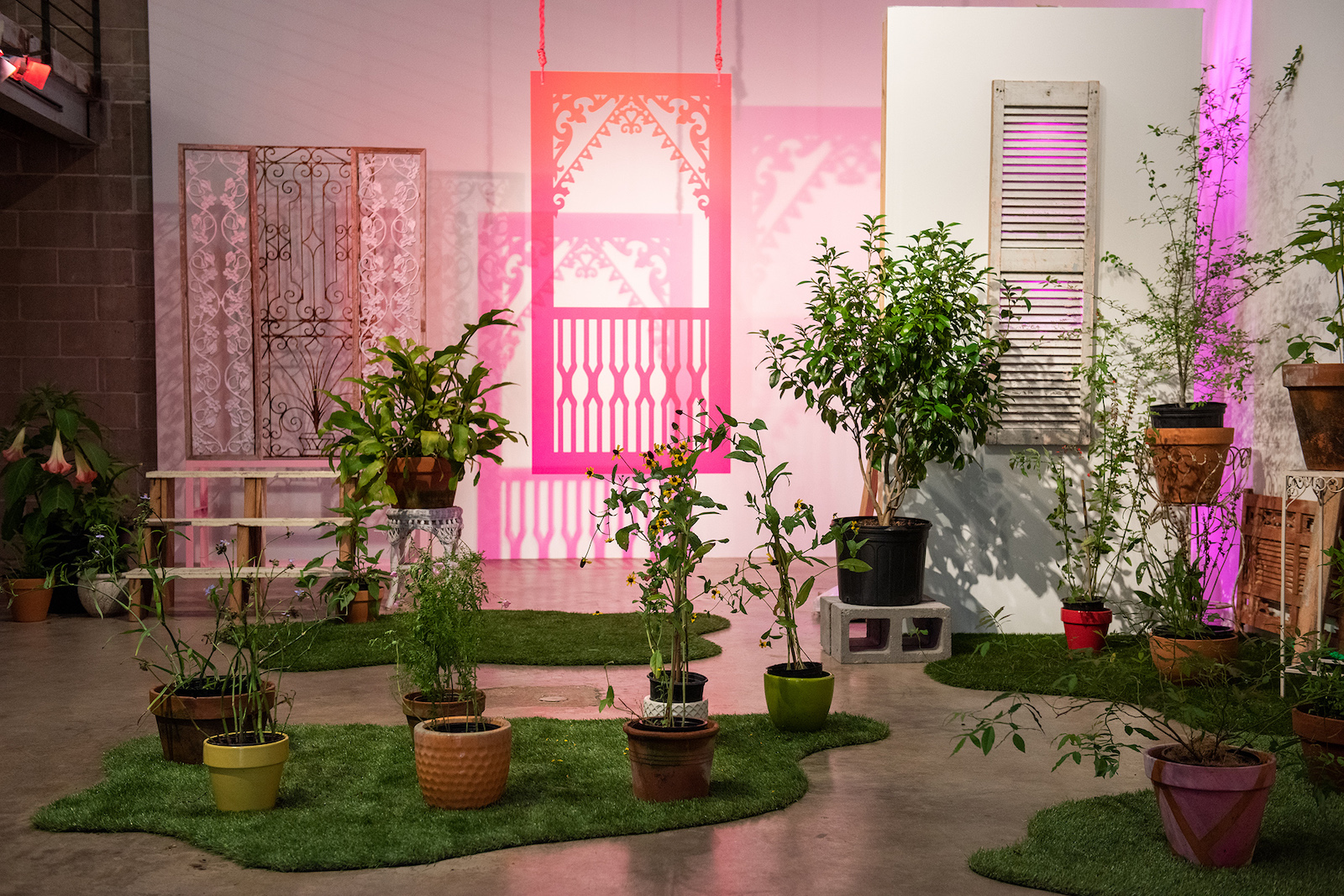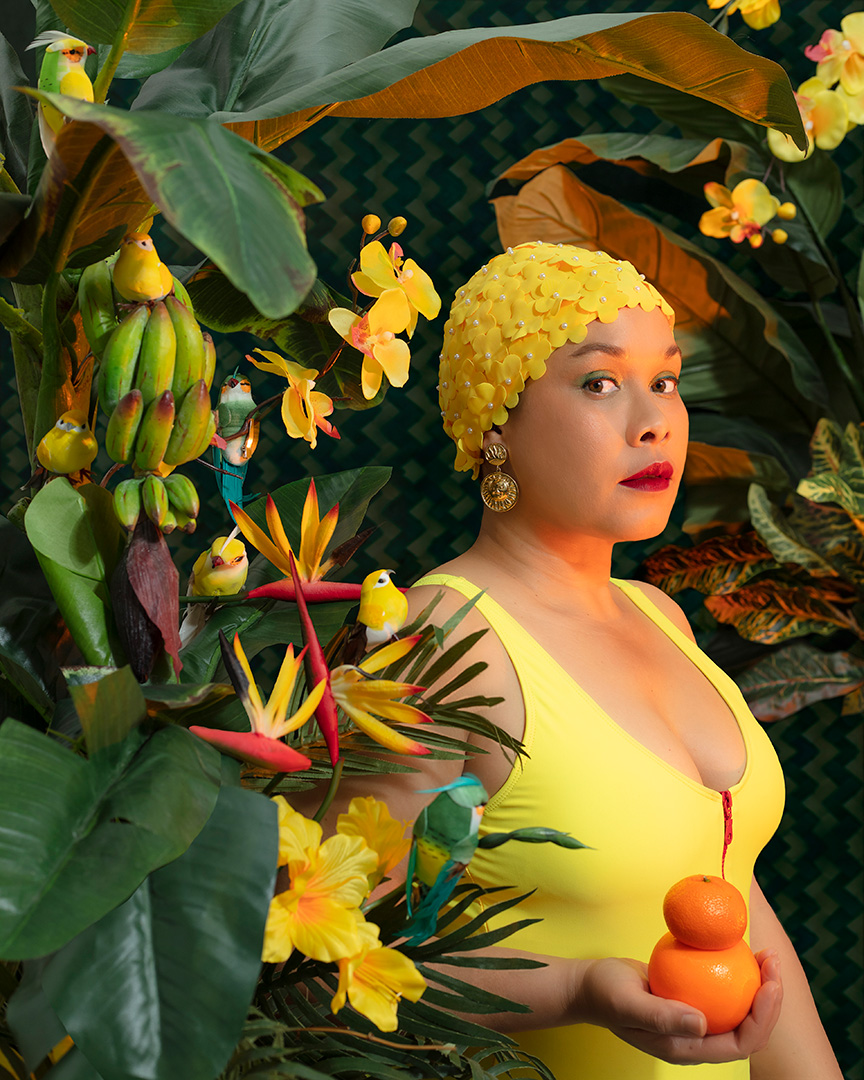
Tiffany Smith, Back Home, installation view, 2024 [courtesy of the artist and TEN NINETEEN, New Orleans, LA]
Tiffany Smith: Back Home
Share:
During my first meeting with artist Tiffany Smith, she showed me a photograph of her grandmother. It was a black-and-white photo that looked to date from some time in the 50s or 60s or 40s. Timeless. Her grandmother was sitting on the beach, slightly reclining, and holding herself up with one arm. An extraordinary image. The sea went on forever. The land sprawling behind her. And the expression on the woman’s face was uncanny. There’s an emotional power, but also, the psyche was not withheld. She was self-possessed. Content. In some spell of home. This photograph of Smith’s grandmother is source material for some of the imagery in Back Home. The remaining photographs in the exhibition come from the body of work For Tropical Girls Who Have Considered Ethnogenesis When the Native Sun is Remote (2014–2024). The work deals with family and home—seed work of a life growing up in Nassau, Bahamas, and Miami, FL. Smith’s family has roots “all over the Caribbean”—in Trinidad, Guyana, Jamaica, Barbados, and the Bahamas. Smith moved to New Orleans earlier this year, called to what’s seen as the northernmost Caribbean city. Stories of migration, inside a feminist reframing of the migratory and the displaced, foreground the portraiture in the show.
The artist takes on various personae. Smith’s personae could be the progeny of Coco Fusco and Guillermo Gómez-Peña’s characters in their iconic performance The Couple in a Cage (1993), in that Smith’s are something akin to liner notes of the process of inhabiting, of performing. Self-portraiture figures prominently in Tiffany Smith’s work, as the artist depicts various characters—tourist, Earth mother, Caribbean queen—to illustrate what might’ve been lost or regained in histories of migration.
This post-coloniality, this diaspora.
In Yellow Bird in Banana Tree (2021), Smith is photographed wearing a yellow swimsuit and Busby Berkeleyish yellow flower-petaled swim cap. The scene is lit from within. Complete with parakeets, a banana tree, a couple of oranges, and other evidence of tropical(e) life, her gaze is as performative as the setting. The framing of the scene is as if, while on a stroll in the jungle, you happened upon this sun goddess, this femme in the foliage. The stalk of engorged green bananas looks close to bursting. You snap out of it, this vision, when you notice the metal clip holding the fake bird and plastic plant limb in place. The setup is an ingenious conceit. The image reminds me of passages from Paul Bowles’ novel Up Above the World, but departed from that work’s creeping dread and menace. The mind blooming canopies of flesh that summon a glimmering and imperfect light. Who? Who?
Tiffany Smith, Yellow Bird in Banana Tree, 2024 [courtesy of the artist and TEN NINETEEN, New Orleans, LA]
Perpetual Tourist (2015) is one of the funniest, smartest, and most affecting images in the series. The subject stands in Adidas high tops, boom-box earrings, and a Walt Disney World sweatshirt. She holds a cloth sack of flowers. There’s a suitcase full of ferns. Silk-screened backdrop with moon. Horizontal space deceives. The Ben-Day dots of the backdrop cue and skew the plane. Also the figure before it. The persona non grata in the photograph is a knowing “token,” a gadfly commentator on colonialism, capitalism, escapism, maybe even colorism. Complexion—the viewer’s perception of the subject’s, if you will—is a character in the image, too.
All told, the work in this exhibition “honors migratory Caribbean histories and locates them in the blend of African diasporic traditions that emerge within the cultural practices and architecture of New Orleans.”
When I think of home, I think of a place where there’s love overflowing … it would sure be nice to be back home.
—Diana Ross, The Wiz
Physical elements of the home Smith grew up in are reimagined in the gallery space—what she remembers of her grandmother’s home. Plants with healing properties, the bulky steps that led up to the house. A doorframe. A hot pink doorframe modeled after the doorframe from the artist’s childhood home hangs, suspended from the rafters of the gallery. It is the threshold the show needs. Although the plotting of vegetation, columns, or trellises “propped” (verb + adjective), and islands of AstroTurf certainly tell a story—one doesn’t quite feel the sense of home until approaching this pulsing marvelous hot-pink thing. Set far back in the space, it pulls everything together. The breaking apart of landscape and home becomes an assertion of the hot-pink egress. It shimmers. It carries and throws light. Its silhouette replicates itself at the rate of dreams to memory to place. I step inside the portaled selves of the artist.
I asked Smith how she did it—the look on her face in each of these images. It’s incalculable, this willing and expressive presence, full of depth and sensitivity. Something in the staging and restaging that feels like an imperative. An urge. An urging. I stick, first, my arm, then my head, through the opening of the hot-pink frame. The color is buzzing. A lung and a mouth duke it out in the corner of a world made by our grandmothers. The rest of the body is twinning space. Ripped. Split. There was landing.
Sherae Rimpsey is an artist and writer. Her book of poetry—neon neon—is available now from SHINKOYO / ARTIST POOL. Rimpsey is the Mildred Thompson Art Writing and Editorial Fellow.
The Mildred Thompson Arts Writing and Editorial Fellowship is a collaboration between Art Papers and Newcomb Art Museum at Tulane University. Funding for the two-year editorial position was provided to Newcomb Art Museum by the Andrew W. Mellon Foundation for an emerging Black arts writer/editor to gain hands-on experience as part of Art Papers’ editorial team. The fellowship also honors and builds upon the legacy of Mildred Thompson, associate editor of ART PAPERS from 1989 to 1997.
Conceptualized as part of Art Papers’ Diversity, Equity, Inclusion, and Accessibility efforts, the fellowship received seed funding from AEC Trust and The Homestead Foundation to pilot the program in 2022.
